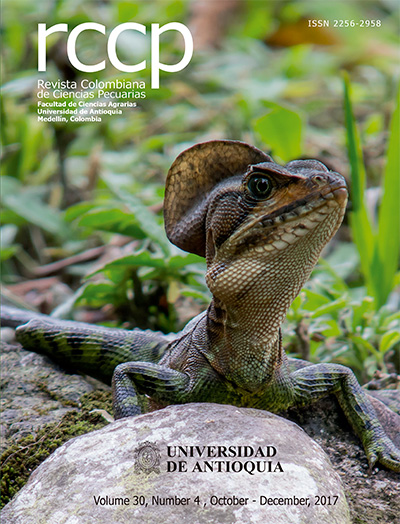Eficácia de um aditivo de levedura para leitoas que consomem ração contaminada por zearalenona
DOI:
https://doi.org/10.17533/udea.rccp.v30n4a05Palavras-chave:
dieta, micotoxinas, Saccharomyces cerevisiae, suínos, parede celular de levedurasResumo
Antecedentes: As micotoxinas determinam perdas econômicas importantes para suinocultura e os adsorventes à base de parede celular de leveduras são uma alternativa para reduzir este problema. Objetivo: Avaliar a eficácia de um aditivo anti-micotoxina (AAM; Safmannan®) na prevenção da micotoxicose decorrente da ingestão de zearalenona (ZEA). Métodos: Foram utilizadas 36 leitoas pré-púberes, cujas dietas apresentaram dois níveis de inclusão de AAM (à base de parede celular de Saccharomyces cerevisiae; 0 e 0,2%) e três níveis de inclusão de ZEA (0, 0,25 e 0,6 ppm). O período experimental teve duração total de 21 d, sendo realizadas avaliações semanais de peso vivo, ganho de peso, consumo de ração e volume vulvar. Pesos relativos de fígado, trato reprodutivo total e o conjunto útero-ovário-vagina também foram calculados. Resultados: Os resultados obtidos demonstram a eficácia do AAM, pois a sua inclusão demonstrou prevenir os efeitos tóxicos da ZEA, já que os índices em órgãos reprodutivos como volume vulvar, peso relativo do trato reprodutivo total e do conjunto útero-ovário-vagina foram maiores nos animais intoxicados e sem suplementação. Porém, o efeito anti-micotoxina foi fixo, sendo o mesmo para os dois níveis de ZEA (0.25 e 0.6 ppm). Conclusão: A adição do AAM em questão nas dietas contendo ZEA demonstrou ser uma alternativa eficiente para redução dos efeitos tóxicos desta micotoxina.
Downloads
Referências
Andretta I, Lovatto PA, Hauschild L, Dilkin P, Garcia GG, Lanferdini E, Cavazini NC, Mallmann CA. Alimentação de leitoas pré-púberes com dietas contendo zearalenona. Arq Bras Med Vet Zootec 2008; 60:1227-1233.
Andretta I, Lovatto PA, Lanferdini E, Lehnen CR, Rossi CAR, Hauschild L, Fraga BN, Garcia GG, Mallmann CA. Alimentação de leitoas pré-púberes com dietas contendo aflatoxinas ou zearalenona. Arch Zootec 2010; 59:123-130.
Arrieta D, Pérez ML, Foncesa JH, Oviedo MG, Miranda S, Luengo A. Efecto Del consumo de cultivo de leveduras Saccharomyces cerevisiae y/o selenio em pollos de engorde expuestos a bajos nivales de Aflatoxina B1 en la dieta. Rev Cient Facult Cienc Vet Univ Zulia 2008; 18:93-102.
Brady D, Stoll AD, Starke LE, Duncan JR. Chemical and enzymatic extraction of heavy-metal binding polymers from isolated cell-walls of Saccharomycescerevisiae. Biotechnol Bioeng 1994; 44:297-302.
Brasil. Ministério da Agricultura, Pecuária e Abastecimento. Portaria nº130, de 24 de maio de 2006. Institui o grupo de trabalho sobre micotoxinas em produtos destinados à alimentação animal. Diário Oficial da União. Brasília: DF; 25 de maio de 2006.
Bryden WL. Mycotoxin contamination of feed supply chain: Implications for animal productivity and feed security. Anim Feed Sci Technol 2012; 173:134-158.
Chatopadhyay P, Pandey A, Chaurasia AK, Upadhyay A, Karmakar S, Singh L. Hepatic hyperplasia and damages induces by zearalenone Fusarium mycotoxins in BALB/c Mice. Arch Gastroenterol 2012; 49:77-81.
Doll S, Danicke S. The Fusarium toxins deoxynivalenol (DON) and zearalenone (ZON) in animal feeding. Prev Vet Med 2011; 102:132-145.
Dumitrescu G, Ștef L, Ștef DS, Drinceanu D, Petculescu CL, Țăranu I, Israel RF, Peț E, Voia OS. Histological modifications induced by the mycotoxin ZEA in weaned piglets and the counteraction of its toxic effect by the use of pre- and probiotics. Rom Biotech Lett 2014; 19:9715-9726.
Fink-Gremmels J, Malekinejad H. Review Clinical effects and biochemichal mechanisms associated with exposure to the mycoestrogen zearalenone. Anim Feed Sci Techol 2007; 137:326-341.
Gajecka M, Slawuta P, Nicpon J, Kolacz R, Kielbowicz Z, Zielonka L, Dabrowski M, Szwida W, Gajecki M, Nicpon J. Zearalenone and its metabolites in the tissue of female wild boars exposed per os to mycotoxins. Toxicon 2016; 114:1-12.
Hauschild L, Lovatto PA, Lehnen CR, Carvalho AA, Garcia GG, Mallmann CA. Digestibilidade e metabolismo de dietas de suínos contendo zearalenona com adição de organoaluminossilicato. Pesq Agropec Bras 2007; 42:219-224.
Huwig A, Freimund S, Kappeli O, Dutler H. Mycotoxin detoxication of animal feed by different adsorbents. Toxicol Lett 2001; 122:179-188.
Jiménez M, Máñez M, Hérnandez E. Influence of water activity and temperature on the production of zearalenone in corn by three Fusarium species. Int J Food Microbiol 1996; 29:417-421.
Mostrom MS. Zearalenone. In: GUPTA, R. C, editors. Veterinary Toxicology: Basic and Clinical Principles. 2nd ed. London: Academic Press, 2012. p. 1266-1271.
Oliver WT, Miles JR, Diaz DE, Dibner JJ, Rottinghaus GE, Harrell RT. Zearalenone enhances reproductive tract development, but does not alter skeletal muscle signaling in prepubertal gilts. Anim Feed Sci Technol 2012; 174:79-85.
Ortiz A, Reuto J, Fajardo E, Sarmiento S, Aguirre A, Arbelaz G, Gómez D, Hidalgo-Quevedo B. Evaluación de la capacidad probiótica “in vitro” de una cepa nativa de Saccharomyces cerevisiae. Univ Sci 2008; 13:138-148.
Shetty PH, Jespersen L. Saccharomyces cerevisiae and lactic acid bacteria as potential mycotoxin decontaminating agents. Trends Food Sci Tech 2006; 17:48-55.
Teixeira LC, Ferreira-Montiani F, Dittrich-Locatelli R, Santini E, Alberton GC. Effects of zearalenone in prepubertal gilts. Pesq Vet Bras 2011; 31:656-662.
Zouboulis AI, Matis KA, Lazaridis NK. Removal of metal ions from simulated wastewater by Saccharomyces yeast biomass: Combining biosorption and flotation processes. Separ Sci Technol 2001; 36:349-365.
Downloads
Publicado
Como Citar
Edição
Seção
Licença
Copyright (c) 2017 Revista Colombiana de Ciencias Pecuarias

Este trabalho está licenciado sob uma licença Creative Commons Attribution-NonCommercial-ShareAlike 4.0 International License.
Os autores autorizam a RCCP a reimprimir o material nela publicado.
A revista permite que o(s) autor(es) detenham os direitos autorais sem restrições, e permitirá que o(s) autor(es) mantenham os direitos de publicação sem restrições.






